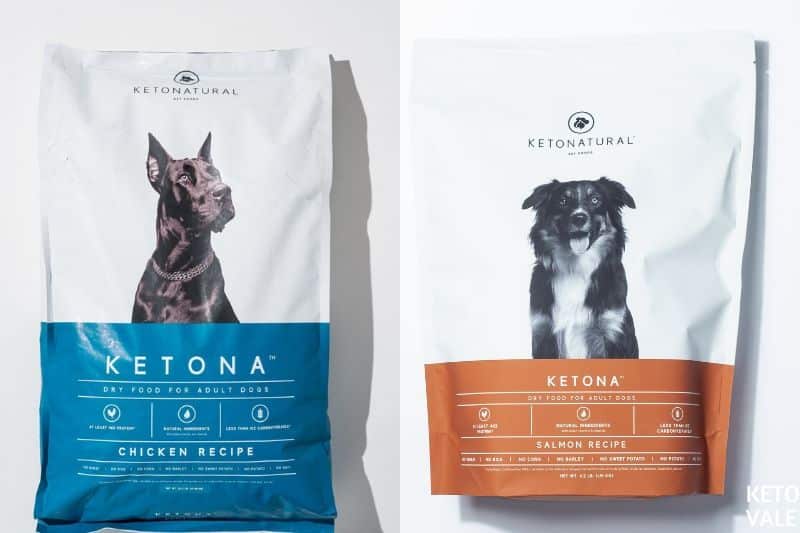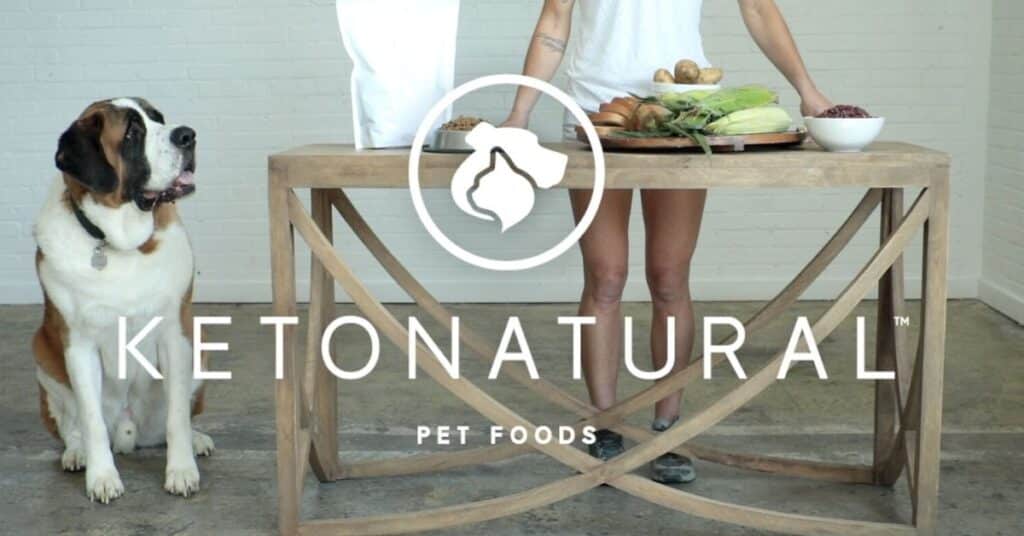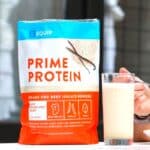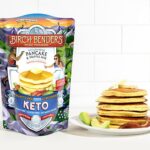Many people have found great success on the keto diet when it comes to losing weight, lowering blood sugar levels, improving cognitive function, and feeling better in general.
But what about man’s best friend? Can dogs experience the same benefits from following a keto diet? After all, dogs are prone to many of the same conditions humans are, such as obesity and diabetes.
As the rise in popularity of the ketogenic diet continues, many people are turning to ketogenic dog food to help their pets achieve the same results.
Ketona dog food by KetoNatural Pet Foods, Inc claims to optimize your dog’s body composition so that they can burn more fat by eating like Mother Nature intended.
Here are some quick facts about the company:
- Ketona dog food, for example, the chicken recipe contains 5% carbs and 46% protein
- Contains no wheat, soy, cereal grains, corn, potatoes, rice, beans, soy, or artificial colors
- Made in the USA from American and Canadian farmers and fisherman
- Vitamin and mineral fortified
- 100% money-back guarantee
Check out our Ketona dog food review below to help decide whether keto dog food is right for your pet, too.
What is Ketonatural Dog Food?
Ketona dog food is a ketogenic brand of dog foods made by KetoNatural Pet Foods that is made with 5% carbohydrates. The food has the nutritional content of a raw diet with the convenience and cost of a kibble diet, according to the website.
The company focuses on high-quality ingredients similar to the ones you probably already eat daily on a keto diet, such as chicken, salmon, flaxseed, and green peas.
They avoid filler ingredients that are commonly found in other grain-free brands of dog food, such as potatoes, cereal grains, and corn byproducts.
The company states that their dog foods can help your dog:
- Burn more body fat and improve blood glucose levels
- Eat as Mother Nature intended
- Optimize body composition
- Support lean muscle mass
KetoNatural Pet Foods was founded by Daniel Schulof, who is also the author of Dogs, Dog Food, and Dogma. The book features a four-year research project that provided links between chronic disease and pet food.
The company believes in providing scientific information to pet owners so that they can make the best decision for their beloved family members regarding the truth behind carbohydrates and pet food.
What Does It Offer?

Ketona dog food comes in two flavors: chicken and salmon. Both are in kibble form. They also sell single-ingredient chicken liver dog treats that are made with freeze-dried chicken livers.
Their food is made primarily for adult dogs and the food comes in various sizes, including 4.2 pounds, 8.4 pounds, 16.8 pounds, and 24.2 pounds.
Here are some of the key ingredients in both flavors: chicken or salmon, chicken or salmon meal, pea protein, ground green peas, oat hulls, pea fiber, flaxseed meal, phosphoric acid, gelatin, sunflower oil, and a vitamin and mineral blend.
The chicken recipe dog food contains the following:
- Dietary Starch: 5.0%
- Sugar: 0.5%
- Crude Protein: 46.0%
Here is the nutritional breakdown of the salmon flavor:
- Dietary carbohydrate: 5.0%
- Sugar: 0.5%
- Crude Protein: 46.0%
According to the product description, the chicken flavor contains 5% carbohydrates, which is 85% less than most commercial dog foods. It also has more than 46% protein to help keep your dog full. The salmon flavor contains less than 5% carbs (90% less than other leading dog food bands) and more than 46% protein.

Ketona Dog Food: Pros and Cons
There are a few ketogenic dog food brands in the marketplace. Ketona dog food appeals to your dog’s omnivorous palate by combining lean meats, fish, and fiber-rich plant foods, such as green peas and flaxseeds. The addition of fiber from oat hulls and peas aids in digestibility to help reduce inflammation and keep your dog feeling her best.
As many experts note, a meat-only diet may lead to nutritional deficiencies. However, Ketona dog food contains a vitamin and mineral blend to ensure a nutritionally-balanced meal every time.
We also like that Ketona dog food does not contain any fillers, preservatives, or cheap ingredients that are nutritionally-poor and may lead to inflammation, such as wheat, corn, and soy.
Dog owners will enjoy the convenience of a kibble food, which is low maintenance, easy to clean up, and does not need to be refrigerated like a raw dog food diet does. You can also visit the website’s scientific-based blog for more information about Ketona food if you’re skeptical.
Here are some other pros and cons to keep in mind:
Pros
- All dog food is made in the USA with natural ingredients, including a vitamin and mineral blend
- Comes in two flavors: chicken in salmon
- Contains NO cereal grains, wheat, soy, potatoes, corn, and artificial flavors or colors
- Provides less than 5% carbs per serving
- May help promote weight loss and reduce blood sugar levels in dogs
- Comes with a 100% money-back guarantee
- Features a kibble food, which is easier to clean and more convenient than a raw food diet
Cons
- Can be expensive at over $100 per 24 pound bag

Should You Feed Your Dog Ketona Dog Food?
KetoNatural uses a science-based approach to creating their dog food. Their food is designed to give your dog the same benefits that you experience on a keto diet, such as better cognitive function, weight loss, and reductions in diabetic and cardiovascular risk factors.
We like that their food contains no artificial ingredients or flavors. The primary ingredients found in both flavors include chicken or salmon, green peas, and flaxseeds. All food is low sugar and high in fiber to help support a healthy lifestyle for your dog.
While there are lots of grain-free dog food options on the market, Ketona stands out because it uses clean ingredients and no fillers, such as corn byproducts, wheat, potatoes, or ingredients that may lead to inflammation.
It also uses fewer carbs than leading grain-free brands of dog food. If you’re not happy with your dog’s current food or you notice that your dog has become less active later in life, then you may want to try a high-quality grain-free food, such as Ketona.
Ketona is designed for adult dogs. We recommend talking to your vet before switching to a low-carb diet if your dog is a puppy or has special medical requirements.
You may want to consider Ketona dog food if the following applies to your dog:
- Your dog is an adult and does not have heart problems
- Your dog struggles with weight gain or lack of energy
- Your dog does not want to play as much as she used to
- Your dog has become diabetic or requires insulin
- Your dog has joint pain, digestive problems, or skin issues
- Your dog seems uninterested in other dog food
Where to buy Ketona
You can buy Ketonatural Dog Food on Amazon or their website, or search “Ketona dog food near me” on Google to see if they have it in your local areas.
Do Dogs Need To Eat Carbs?
If the rise of the ketogenic diet has taught us anything, it’s that people do not need to eat as many carbohydrates as once thought.
In fact, studies show that low-carb diets have numerous health benefits, including weight loss, improvements in blood sugar and insulin response, and reduced risk factors for Alzheimer’s disease and cardiovascular disease (1).
But what about a dog’s nutritional needs? The majority of generic dog food brands contain ingredients that no ketogenic dieter would eat themselves, such as corn gluten meal, meat byproducts, and even food coloring.
This has prompted many pet owners to search for a better way by sifting through the variety of gluten-free, grain-free, and low-carb dog food options available now.
But are they really better for your dog? And how many carbs do dogs need, anyway?
According to the Veterinary Centers of America (VCA) Hospital, the dog species belongs to a scientific order called Carnivora. Animals in this group share a similar tooth structure.
Some animals in this group, including the obligates or true carnivores, absolutely need to eat meat. Others in this group, called herbivores, can get most of their nutrition from plants (2).
The VCA hospital notes a dog’s intestinal tract and tooth structure have become adapted to an omnivorous diet. This means they can eat a combination of plants and meat.
The experts at the VCA hospital noted that a dog’s digestive system produces enzymes that are needed to break down starches and sugars. This means that dogs CAN digest carbs. However, the VCA notes that dogs have evolved into using primarily fats and proteins as their main energy source.
Additionally, research shows that grey wolves (whom many domestic dogs derived from 13,000 and 17,000 years ago) are true carnivores that eat very little plants. One study indicated that wolves lead a “feast and famine” lifestyle that is still present in modern-day dogs (3).
However, many other dog foods differ in terms of the dietary nutrient profile that the dog’s closest living ancestor eats. This is why so many pet owners are convinced that their furry friends would do better on a low-carb diet like the one their ancestors ate.
Before you decide to feed your dog like a wolf, keep in mind that just like people, no two dogs are the same. Some do fine on a mostly plant-based diet high in carbs while others do not.
The VCA notes that the best dog food to buy is one that’s highly digestible. For some dogs, this might mean eating cooked grains as opposed to raw plants.
Other dogs may find improvements in their digestive system by cutting carbs and focusing on meat. Keep your dog’s life stage and energy levels in mind before cutting out carbs or making different dog food recipes entirely.
Should Your Dog Follow The Ketogenic Diet?
Although they are vastly different from us, dogs suffer from similar conditions that people do. For example, research shows that epilepsy is the most common brain disease among dogs (4).
Doctors have been using the ketogenic diet to treat epilepsy in humans since the 1920’s (5). In fact, that’s how the diet became popular. Now, research shows that dogs can be treated the same way (4).
Dogs also appear to benefit from cutting the carbs when it comes to weight loss and improved insulin levels. Here are some other ways a ketogenic diet can benefits dogs:
#1. Low-carb diets may promote weight loss while sparing lean body mass.
According to one study, a high-protein and low-carb diet enhances weight loss in dogs (6).
Researchers noted that dogs lost more body fat and spared more lean body mass when they were fed a high-protein, low-carb diet (47.5% protein) when compared to a low-protein diet (23.8% protein) (7).
#2. Dogs may prefer fat over carbohydrates.
When it comes to your dog’s food preference, some research shows that dogs may not even want to eat carbohydrates if fat is present.
Researchers from one study determined that dogs may still have a “feast or famine” mentality where they prefer fat over protein at first.
They also determined that when given the option, dogs do not select carbs as a significant part of their diet (8).
Another study found that when given the choice, dogs went for meals that contained 41 percent fat and 36 percent carbs, suggesting that dogs would rather eat a high-fat diet (9).
However, researchers noted that your dog’s age and body mass index may set a physiological basis for what they chose to eat.
In this study, younger dogs with less body fat were less interested in high-protein foods, whereas dogs that had the most body fat were more interested in protein (9).
#3. Lower carb diets may help improve diabetic conditions.
Many people turn to low-carb diets to help improve type 2 diabetes. Because carbohydrates induce an insulin spike, studies show improvements in glucose levels when carbs are reduced.
One study found that diabetic dogs may also benefit from lower-carb diets. Researchers studied the insulin concentrations and postprandial plasma glucose effects of three different dog diets.
Results indicated that postprandial glucose concentrations were lower in moderate carb diets than in higher carbs diets, suggesting that a low-carb diet may improve diabetic conditions if you have a diabetic dog (10).
#4. High-fat diets enriched with MCTs may improve canine epilepsy, reduce anxiety, and boost cognition.
Medium chain fatty acids (MCTs) contain numerous health benefits, including weight control, improved energy levels, cognitive support, and protection against several diseases.
One study found that MCTs and a high-fat ketogenic diet can be used to help treat canine epilepsy. Researchers determined that an MCT-enriched diet improved seizure control in dogs.
It also improved attention-deficit hyperactivity disorder (ADHD) related behavior as well as anxiety and fear in dogs with epilepsy. Finally, MCTs appear to boost cognition in older dogs (11).
#5. When combined with intermittent fasting, a low-carb diet may improve insulin levels and support immunity in dogs.
Many ketogenic dieters use intermittent fasting to boost their health benefits.
Intermittent fasting has been shown to delay aging, improve blood glucose levels, increase lifespan, reduce ischemic tissue damage, improve neural repair after injury, and delay neurodegenerative diseases (12).
One study found that dogs on an intermittent fasting, high-fat diet lowered their blood glucose and insulin concentrations (12).
Additionally, the researchers noted that there was a decline in immune parameters in dogs on a low-fat, intermittent fasting diet but not dogs that were fed a high-fat, intermittent fasting diet (12).
Possible Side Effects of a Low Carb Diet in Dogs
Pet owners can always tell when something is not right. If your dog experiences a decrease in energy, weight changes, or heart problems, then it might be time to talk to your vet about a feeding change.
While low-carb dog food may have numerous benefits for some dogs, it might not be right for yours. Dogs are unique, just like people. Finding the right balance of carbs, fat, and protein might take some work before you find the winning combination for your dog.
According to the FDA, there were some reports of canine dilated cardiomyopathy (DCM) in dogs eating grain-free food (13). DCM is a disease that affects the cardiac muscle and causes a decreased ability in the heart to pump blood through the body (14).
Here are some other possible side effects of a low-carb diet in dogs (14):
- Reduced energy or weakness
- Constipation or other digestive problems
- Coughing or increased respiratory rate
- Weight changes
- Abdominal distention
For more information about your dog’s dietary needs, we recommend consulting your vet, especially if your dog is a puppy or has an underlying medical condition as these conditions may require special dietary needs.
Conclusion
The ketogenic diet has many proven health benefits in humans. However, research on the effects of a low-carb diet for dogs is only just beginning to show the possible health benefits.
According to the experts at the VCA Hospital, dogs produce enzymes that break down carbohydrates, which means that they CAN eat carbs. However, dogs have evolved into using protein and fat as their primary source of fuel. As omnivores, dogs can eat both plants and meat.
Ketona is a ketogenic dog food that contains less than 8% of carbs. The food is made in the USA and contains no artificial or inflammatory ingredients, such as corn, soy, wheat, or grains.
Feeding your dog a low-carb diet may help improve her weight, insulin levels, energy, mood, and more. Ketona offers a money-back guarantee if you’re not satisfied with their food.
Always check with your vet if you have questions about a low-carb diet. For more information, check out the Ketona website.
*Disclaimer: Please always consult with your vet first when it comes to changing diets to see which diet is best for your dog’s individual needs, especially if your pet has any underlying conditions.







